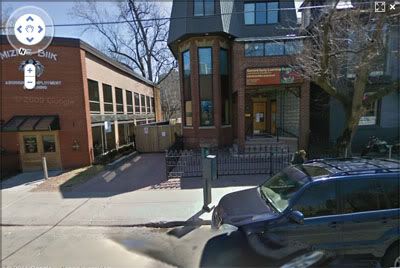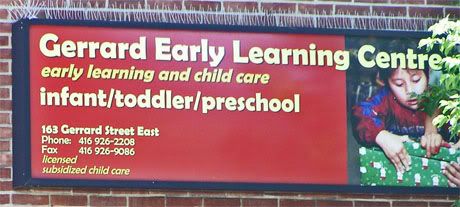 |
Gerrard Early Learning Centre, between Miziwe Biik Aboriginal Employment
and Training and Take a Walk on the Wildside (the gray townhouse), "a business geared to Crossdressers, Transvestites, Drag Queens, Transsexuals, All Transgendered People, Their Spouses, Friends, and Lovers."
 |
Notice how the child is of some undefined non-white race/ethnicity (is he Chinese/Mexican/Vietnamese). Multicultural in Canada means (and favors) non-whites.
 |
The Gerrard Early Learning Centre is the brick townhouse next to the gray building, which sells transvestite/transsexual paraphernalia. An aboriginal center has taken over the large brick building which extends out onto the left. Imagine the children (toddlers) passing by the transvestite/transsexual store, with the occasional transvestite/transsexual actually passing them by? What are they to make of these creatures?
Early Learning Centre is a euphemism for day care center. I would think this appellation is to distract parents that the institution they are sending their children to for the better part of the day is a place where they can learn many fun things (sing nursery rhymes?), but they're not in the more rigorous school setting preschool implies. And it certainly not some glorified baby sitting center (but it is!).
The center also provides subsidized child care.
-------------------------------------------------------------------------------
I was right about the daily destination of my young neighbor.
Below is an excerpt what I wrote about him a couple of weeks ago:
The family across the street from my building has done a great job of renovating its home. There is a lovely garden. The house is a pretty duplex, with what looks like a Chinese family living above, which seems very friendly with this family.Later on I wondered if the child (only a toddler, probably two years old) is being wheeled over to the neighborhood daycare center:
Their son is a rambunctious little boy (a toddler), with blond hair and blue eyes, who tears around the small garden when he gets out to play (which is about twice a day).
A few weeks ago, I went to the father while he was in the garden and told him to be careful, that such a lovely boy with such a loud voice, playing outside, is likely to attract attention...
I felt sorry for the father. I couldn't offer him any solutions, but could only point out the dangers. I notice now that the little boy is playing less frequently outside, and there is always someone with him. Most of the time, though, it is the Chinese woman from upstairs [Note: I presumed she was a tenant in the townhouse]. I don't understand this. This goes back to my original concern (observation) that this family doesn't really seem to be thinking about the boy, but about their "needs": to have a nice house, to have a ready baby sitter (I'm not sure if they pay the Chinese woman, but they must since she's almost always with him now)...
Early this morning, I hear the boisterous screams of my young neighbor which turn into uncontrollable crying. I look out my window, and there he is, with the Chinese/Asian (she might even be Filipino) woman pushing on one of his shoes. The boy then gets hauled up by the woman. He keeps turning back to his watching parents for help, hanging on to the railings of the fence, squirming and writhing. His crying turns into wailing, but to no avail. He's off somewhere. The clever "babysitter" (who is pretty small, but pretty adept at managing crying and struggling toddlers) pulls and turns him away from the parents, and walks across the street. His overweight parents stand watching on the porch, the father, much more concerned than the mother, leaning forward trying hard not to intervene in this necessary step of his son's education. The mother soon gets tired of standing watching, and walks back into the house. The father follows docilely behind.I was right. He is sent to the day care center around the corner. I walked by it late in the afternoon a couple of days ago (around 5 pm - isn't that a very long day for such young children?), and passed by the multi-child strollers (three with about six in each) that were wheeling the children around (as an outing?!), and recognized his voice. I actually re-traced my steps to have a good look. And there he was, strapped in his seat, looking uncomfortable, but restrained and quiet. He was amidst a whole smörgåsbord of toddlers, Chinese, black, Hispanic, but with a smattering of white kids, and the stroller pushers (the adults, or employees) themselves reflected the multi-culti face of Toronto: one was a hijabed Muslim, another was Chinese, another was black, and one more was white. I looked up information on the day care via Google Map, and eventually found its name and services:
Location (Intersection): Toronto Central (Jarvis St-Gerrard St E.)"Subsidies may be available," and "Non Profit," ring warning bells. Subsidies for whom? Why non profit? I had mentioned earlier that I talked with a black woman (who sounded Nigerian) walking by the center if she had any children there, and she had one child. I asked if it was expensive, and she said that subsidies are available. This woman was running off (to work, I presume, and the government has obligingly provided her with a means to drop off her child while she's out making minimum wage). In fact, one can only be eligible for child care subsidy if one is working. Here the website for the City of Toronto on the eligiblity for subsidized child care:
Ward: Toronto Centre-Rosedale (Ward 27)
Languages of service: English; other languages may be available
Eligibility: Birth-5 years
Fees: Subsidies may be available
Physical access: Not wheelchair accessible
Service description: Licenced child care centre - capacity 60
Organization type: Non Profit
To qualify for a child care fee subsidy you must meet the following five conditions:Here is some of what the Public Health Agency of Canada, under its Child Health division says:
- You must live in Toronto or be an employee of the City of Toronto.
- You must be the parent or guardian of a child under the age of 10 years.
- You must be employed, in school or in an approved training program. Even if you are not yet employed or in school, you may still apply to get on the waiting list. If you or your child has a special need, you may also qualify - learn more.
- You must be looking to place your child in care in a licensed child care program that has a fee subsidy contract.
Note: for some programs, you may have to pay a registration fee and/or a deposit.
- You must be in financial need. Eligibility for child care fee subsidy is based on a family's net income as reported on the Canada Child Tax Benefit (CCTB) statement or on the Revenue Canada, Notice of Assessment (NOA). If you are missing this information, call the Canada Revenue Agency. For your CCTB statement, call 1-800-387-1193. For your NOA, call 1-800-959-8281.
- Use the fee subsidy calculator to estimate how much you will pay for child care.
Note: if you are a new immigrant or a new resident to Canada, you can apply before you have to file your first tax return.
Public Health Canada has a wide variety of programs and strategies to promote and protect the health of children. Family Health programs address such issues as low birth weight, healthy birth outcomes, postpartum adjustment, breastfeeding, parenting, child development and readiness to learn, and children's mental health. This is done through programs such as Healthy Babies and Children, Healthiest Babies Possible, prenatal education and support, Nobody's Perfect parenting, Preschool Speech and Language Services, and Kids Have Stress Too. Healthy Lifestyle programs address such issues as healthy eating habits, physical activity levels, safety in the home and community, exposure to environmental tobacco smoke. Healthy Lifestyle programs include Peer Nutrition, Child/School Nutrition, Playground Games, Breathing Spaces and the "Not to Kids" program. Communicable Disease programs aim to reduce the incidence and transmission of infectious diseases through assessment of immunization and response to communicable disease cases and outbreaks, including child care settings. Healthy Environment programs address the issues of food safety, health hazards, tobacco control and injury prevention in community settings. The Dental Health program aims to improve the oral health of children by providing dental treatment to children whose parents cannot afford to pay through private practice.I would presume that day care centers can apply for numerous grants from the many programs slotted for subsidies. This is set up so that poor, single mothers can go out working some minimum wage job that cannot pay for private childcare.
(Of course, the issue is bigger than "poor, single mothers" in a culture that encourages households without fathers, who are usually better and more consistent wage earners than mothers or single mothers, a society with a liberal divorce system that encourages women to "do it alone," and a taxation system that funnels money into programs like these. But that is for another discussion.)
Two-career, wealthier families can also send their children to this day care, but, fairly, pay their share of the costs based on a fair sliding scale fee. The richer mingle with the poorer. The cultures mingle with each other. The smart kids sing songs with the more intellectually challenged ones. "We are all equal" starts early in the education of a child in liberal Canada.
This leaves the parents of this young child all day to do whatever they wish to do during the day. I had walked past the mother recently one evening, dressed in business attire. I presume that she was out at work. So, this family looks like the typical two-income family, with a new house, a young toddler, and a full time baby sitter.